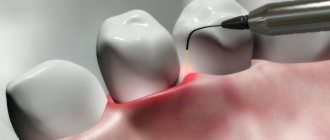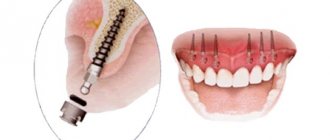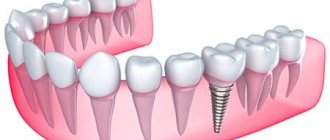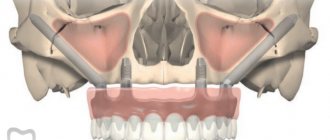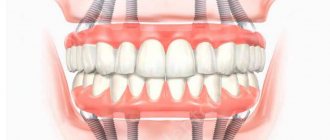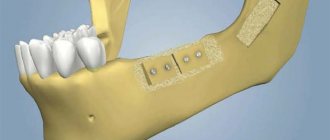1467
Restoring the integrity of the dentition using dental implants is a very popular procedure in modern dentistry.
It has several different implementation methods, the classic one of which is the two-stage implantation protocol.
This method of surgery has been used for many decades and allows you to get rid of both single gaps in the jaw and restore all the missing elements of a row, which is characteristic of complete edentia.
General overview
Classic or two-stage dental implantation is a procedure of implanting a titanium rod into the jaw bone tissue, after which an abutment is installed, which makes it possible for further prosthetics.
This method of restoring the jaw row received its name due to the fact that its stages are significantly separated in time, that is, from the introduction of an artificial root into the bone tissue to the fixation of the crown, it often takes from two to six months.
This allows the metal base to firmly fuse with the bone tissue of the jaw, which reduces the risk of subsequent rejection of the structure.
Advantages
The two-stage implantation technique is in great demand due to its many advantages. When drawing up a treatment plan, the following positive aspects of the procedure become key for the dentist:
- the possibility of restoring a smile in the absence of teeth on one or both jaws;
- high reliability of this method of implanting a metal rod due to its complete osseointegration even before the installation of an artificial crown;
- a wide selection of models and brands of implants that can be used with the classical procedure;
- minimal risk of design rejection;
- preventing bone tissue atrophy and accelerating its growth after the introduction of a titanium rod;
- high final aesthetic indicator , thanks to the use of a special gum former, which promotes the correct growth of gum tissue around the protruding part of the structure;
- the possibility of using the implant for various types of prostheses.
In addition to all the listed advantages of the implantation method, patients note another important point - the absence of the need to make a one-time fee.
Cash payments for the procedure are evenly distributed over time.
Flaws
Along with its advantages, the classical implantation procedure is not without some disadvantages. The most significant of them are the following points:
- Long procedure time. Fixation of an artificial crown requires completion of the osseointegration process, which may take several months.
- Regular visits to the dentist. Throughout the entire period of engraftment of the titanium rod, the patient will have to visit the attending physician periodically to monitor the progress of the process and avoid the development of complications.
- Poor aesthetics of the jaw row during implant healing. Fixation of the crown occurs only after osseointegration of the artificial root is completed, which is why the patient has to have gaps in the dentition for a long time.
Indications
The two-stage implantation procedure is indicated both in the absence of one tooth and in the case of multiple damage to the elements of the jaw row.
In addition, dentists recommend this method of implantation in the following situations:
- looseness of bone tissue;
- low rate of healing of wound surfaces;
- a long period of time after tooth extraction, as a result of which the formation of gum tissue is required;
- presence of problems with gums;
- smoking, which makes another type of implantation impossible.
In what case is basal dental implantation indicated, and patient reviews about the method.
Read here about the advantages of dentures with mini-implants.
At this address https://zubovv.ru/implantatsiya/metodiki/v-kakuyu-summu-oboydetsya-stoimost-pod-klyuch.html we will calculate the cost of a turnkey dental implant.
Indications and contraindications for the procedure
This technique is recommended for people who have lost one or more teeth. It can also be performed for some serious diseases - for example, diabetes.
Two-stage implantation is indicated in the absence of high-quality oral care.
Despite the many benefits, the procedure may not be used by everyone. Contraindications to its implementation are as follows:
- insufficient tissue volume (soft or bone);
- periodontal disease;
- osteoporosis;
- mental and immune system disorders;
- diabetes;
- allergy to pain relief;
- oncology;
- bad habits;
- tuberculosis;
- malocclusion;
- severe heart pathologies;
- schizophrenia;
- metal intolerance.
Ignoring contraindications can lead to serious complications.
Doctors Association
- An implant is implanted into the jaw bone and sutures are placed. If necessary, the missing part of the bone tissue is preliminarily increased. Engraftment takes several months.
- After this period is over, the gum former is attached to the implant, then the abutment, and finally the prosthesis.
- If bone tissue atrophy occurs, bone grafting is necessary. Titanium structures can only be implanted if there is mature bone tissue.
- If it is not possible to install an implant in place of the missing tooth, you should wait until the hole closes. This process usually takes up to 3 months.
Complications due to surgery and infection are possible. To minimize the likelihood of their occurrence, it is important to carefully follow your doctor’s recommendations.
By installing dental implants, various problems can be solved in one day. This type of prosthetics allows you to restore both a serious violation of the dentition and make a prosthesis for just one tooth. If a single implant is installed, a crown is placed with a height slightly less than the natural teeth to reduce pressure on the bone at the installation site.
DETAILS: Implantation can be for two teeth
The accelerated method is recommended for use in cases of periodontitis and periodontal disease, receding gums, and thinning of bone tissue. Also, a one-step procedure will help quickly restore a beautiful smile and the ability to eat normally for those who are not willing to wait a long time and endure inconvenience.
Express implantation is also used in cases where there is complete edentia (absence of teeth) of the upper or lower jaw. A technique has been developed in which the patient is given implants of 4-6 teeth, and a prosthesis that recreates the entire dentition will be supported on them.
Not all patients have the opportunity to use this type of dental prosthetics. For certain conditions, your doctor may recommend alternative methods to implantation. Direct contraindications to this procedure are:
- HIV infection and other diseases of the immune system;
- advanced osteoporosis;
- oncological diseases;
- bleeding disorders;
- connective tissue pathologies;
- decompensated diabetes;
- tuberculosis;
- sinusitis.
Implantation is not performed for pregnant and lactating women or for acute infections. If you have severe chronic diseases, you must first treat them and wait until they are in remission. To identify possible health problems, it is recommended to undergo a preliminary examination.
To understand which protocol to use, the doctor only needs a visual examination and a panoramic photo of the jaw (OPGT). In more complex cases, a CT scan may be required for a complete picture.
An X-ray examination gives the implantologist an idea of the parameters and condition of the patient’s jawbone, the proximity of the mandibular nerve and the maxillary sinus, the presence of inflammation and neoplasms. This data allows you to choose the right technology.
If the doctor prefers a two-stage technique, treatment follows the following scheme (you can follow the stages of treatment in the photo below):
- Stage 1 – Implantation. Under local anesthesia or general anesthesia (depending on the patient’s wishes), the doctor cuts the mucous membrane, folds back a flap of gum, exposing the bone tissue. Then a hole is made in the jawbone with a special drill, a steel root-shaped pin with a plug is implanted, and bone material is added if necessary. At the end the gum is sutured.
- Stage 2 – Prosthetics. After osseointegration is completed, the patient comes for a repeat operation to open the implant. During the operation, the doctor cuts the mucous membrane, providing access to the implant, installs the gum former and suturing the gum. After 7 days, the gum former is replaced with an abutment and a temporary plastic crown, and after a few months a permanent crown is installed.
Timing: The operation lasts from 30-60 minutes. The healing period is 7 days. The osseointegration time of the implanted pin is from 4 to 6 months.
Implantation can also be carried out using a minimally invasive method, without incision of the mucous membrane. In this case, a surgical template is used and the implant is implanted through a puncture in the gum.
Important: Before installing an implant, teeth adjacent to the implantation area must be treated for caries and cleaned of tartar.
Timing: The operation lasts 30-60 minutes. The healing period is 7 days. The total duration of treatment using a two-stage method is from 4 to 8 months.
Scheme of classical two-stage implantation
The Novadent clinic uses classic two-stage implants from the following brands: Nobel (Switzerland), Astra Tech (Sweden), MIS (Israel), Osstem, Implantium, AnyOne (South Korea).
Contraindications
Implantation according to the classical protocol is a dental operation during which an implant is surgically implanted and osseointegrates without load, sutured with a flap of gum tissue. The operation takes place under local anesthesia and lasts about 30-60 minutes, depending on the number of teeth being restored. After 3-4 months, permanent prosthetics are performed using any selected material.
The indication for surgery is any number of missing teeth - from a single defect to complete edentia of both jaws. Classic implants are suitable for installing a single crown, as well as for fixing a bridge or a complete conditionally removable denture.
The first stage involves the following procedures:
- Preparation - it is necessary to conduct an examination, take a targeted X-ray and an orthopantomogram, in some cases a CT scan is also required, it is important to ensure that there are no contraindications and that the classical protocol has been objectively chosen.
- Surgery – the patient is anesthetized at the implantation site, the surgeon peels off a triangular flap of tissue, forms a bed, and installs the implant. The gum flap is returned to its place and sutured. After 7 days, the stitches are removed.
Between the first and second stages, the patient visits the implantologist once a month to monitor proper engraftment. The duration of osseointegration is individual in each case and depends on the quality of the bone tissue.
At the second stage, the following procedures are performed:
- Under local anesthesia, the gum above the implant is opened, an abutment is installed on the top of the rod - an adapter for the future crown, and a gum former, which is responsible for gingival aesthetics.
- Impressions are taken and prosthetics are made.
- Permanent prosthetics are performed.
When planning to restore teeth with titanium implants, it is important to understand that the level of costs will depend on the implant system you choose. If we are talking about the need to restore teeth inexpensively and with high quality, it makes sense to pay attention to two-stage implantation Alfa Bio - the Israeli manufacturer guarantees the effectiveness of its products and works in the budget price segment.
If you want classic dental implantation to be carried out using premium materials, you can give preference to the elite brand Nobel Biocare. Dentists around the world successfully install these implants on patients who are willing to pay for premium quality.
Implantation in the smile area is usually carried out in a one-stage manner with the immediate installation of a temporary crown. But if it is necessary to replace a tooth in the chewing region, then there is no need to rush, since the implant will have to withstand a significant load in the future, and its primary stabilization plays an important role.
If earlier implantation in two stages was the only way to implant titanium roots, today, with the development of the industry and the advent of new techniques, specialists in each specific case thoroughly study the clinical picture of the patient in order to determine the optimal treatment option. Thus, the common question about what is better - one-stage or two-stage implantation, does not sound entirely correct, since each of these procedures is used depending on the specific features of a particular case.
The main difference between the above-mentioned methods is that with one-stage implantation, a titanium root is installed immediately after tooth extraction into the vacated socket, while two-stage implantation involves greater invasiveness using flap technology for cutting soft tissue to gain access to the bone.
If we compare one- and two-stage dental implantation, then in the first case the titanium structure is implanted through a small puncture in the gum. But this technology is not suitable for everyone, since it requires sufficient bone volume and is not used with a narrow alveolar ridge. In general, only on the basis of a complete examination can a choice be made between one-stage, one-stage and two-stage dental implantation, because each of the listed methods has its own indications and limitations.
- the waiting time usually spent on bone tissue formation and socket healing after tooth extraction is reduced;
- minimization of intervention - no incision is required to gain access to the bone, no re-incision is required after engraftment (as is the case with two-stage implantation), which means the volume of medications taken by the patient is reduced and less local anesthetics are required;
- a relatively easier rehabilitation period, less severe symptoms after the intervention;
- easy to predict the conditions and structures of soft tissues, post-implantation structure, alveolar ridge atrophy;
- aesthetics - the temporary prosthesis looks natural, which is especially important when restoring teeth in the smile area;
- saving time - fewer visits to the doctor, the ability to perform all manipulations in one appointment;
- does not require prior bone grafting;
- allows you to preserve the natural contour of the gums, eliminating the need for soft tissue plastic surgery, as in cases where a tooth has been missing for a long time;
- adaptation to the crown (temporary) occurs immediately after the intervention;
- long service life of implants and a high degree of survival if all conditions are met.
- long service life of implants;
- high survival rate;
- the possibility of restoring the dentition in cases where one-stage implantation is impossible - with insufficient bone width, inflammatory processes, and some structural changes in bone tissue.
DETAILS: Actions after dental implantation
Contraindications
The classical implantation procedure is quite complex and time-consuming, and therefore has an impressive list of contraindications.
Among the absolute prohibitions on performing surgery, dentists point out the following points:
- disturbance of the patient's mental state;
- diseases that reduce blood clotting;
- the presence of malignant tumors, the growth of which can be activated as a result of surgical intervention;
- diabetes;
- HIV;
- systemic connective tissue lesions;
- increased tone of the jaw muscles.
Contraindications that can be eliminated before the procedure are considered relative. In the case of two-stage implantation, these include the following body conditions:
- the occurrence of an inflammatory process on the oral mucosa;
- inflammation of some elements of the jaw row, their damage by caries;
- abnormal bite;
- some sexually transmitted diseases;
- low quality of oral hygiene;
- pregnancy period.
When is two-stage dental implantation used?
With two-stage or classic implantation, the procedure for installing a prosthesis is divided into two stages. First, an incision is made in the gum tissue and a hole is prepared in the jawbone to insert the artificial root. After the implant is inserted, sutures are placed on the gums. When the implant healing period is completed, an incision is made on the gum again, and a special attachment is installed on the artificial root to ensure that the gum is given the desired shape. Once the gum is formed, which usually takes from two weeks to a month, a special adapter called an abutment is placed on top of the implant and serves as the basis for an artificial crown.
In general, at least two months pass from the introduction of an artificial root to the installation of a crown. In some cases, the entire process takes about six months. During this entire period, the patient should avoid increased stress on the gums.
Indications for two-stage dental implantation
The classic method of implantation is used for the following indications:
- the presence of general diseases of the body;
- the patient has a habit of smoking tobacco;
- too loose bone tissue;
- slow wound healing;
- the need for gum formation in case of a long period of time elapsed after tooth extraction;
- problematic gums.
An argument in favor of using two-stage implantation is also if the patient does not maintain good oral hygiene. In this case, with rapid installation of implants, the risk of infectious tissue infection increases, which can lead to implant rejection.
Contraindications for classical implantation
The traditional method of installing dental implants also has its contraindications. This method is not applicable in the following cases:
- For blood diseases;
- For dysfunctions of the central nervous system and psychoneurological disorders;
- If there are any tumors in the oral cavity;
- For immune disorders;
- For systemic connective tissue lesions;
- For diabetes.
If the patient has diseases such as caries, pulpitis or periodontitis, as well as inflammatory processes in the oral mucosa, implantation becomes permissible only after these problems have been eliminated.
If several months have passed since the patient’s tooth was removed, a thorough examination of the jaw bone tissue is required. Over the past period of time, the bone could, due to lack of load, atrophy so much that it is no longer possible to install an artificial root in it. In this case, you will need to artificially increase the volume of the bone - bone grafting.
Order of conduct
The classical implantation technique includes several stages separated in time, during which the dentist undertakes certain procedures to successfully restore the integrity of the jaw row.
Preparatory stage
The immediate start of implantation is preceded by a history taking and a thorough examination of the patient’s oral cavity, during which the specialist determines the presence of contraindications and examines the condition of the oral cavity.
Using radiography or tomography, the volume and quality of the jaw bone tissue is examined.
If its volume is insufficient, the dentist decides on the need for bone grafting. In some cases, surgery may be required to increase the thickness of the floor of the maxillary sinus.
Another goal of the preparatory stage is to identify existing dental diseases. If inflammation of the mucous membrane of the gums, carious lesions of teeth or other pathological conditions is detected, they are eliminated.
Sanitation of the oral cavity allows you not only to get rid of existing problems, but also to minimize the risk of further infection of the area that will be subject to surgery.
Surgical stage
During the surgical stage, a titanium rod is directly introduced into the bone tissue of the patient’s jaw. This is done as follows:
- To numb the area of the jaw being treated, the specialist administers a local or general anesthetic drug.
- Using a scalpel, an incision is made in the gum tissue and a flap is removed to provide access to the bone tissue.
- Using a special set of instruments, the dentist drills a conical or cylindrical recess into the bone, depending on the selected implant model. The prepared bed is processed using a suitable cutter and is also cleared of bone fragments.
- A titanium rod of a predetermined shape, length and model is screwed into the prepared hole and closed with a plug. At this stage, the dentist requires increased attention and accuracy to avoid overheating and damage to the bone.
- The detached gum flap is placed in its original position and fixed with suture material.
At this point, the first stage of the surgical stage is considered complete. The process of implanting a titanium rod into bone tissue takes from 2 to 5-6 months, during which no action is taken by the dentist.
Once the osseointegration process is complete, it becomes necessary to create a proper gum line, as gum growth may vary during this period.
For this reason, the second stage of the surgical stage is the installation of the healing abutment, which is carried out as follows:
- The soft tissue is numbed with a local anesthetic.
- A small piece of tissue is removed from the gum in the area of the implant.
- The previously attached plug is separated from the titanium rod integrated into the bone tissue, and a gum former is placed in its place. Healing of the resulting wound occurs within 10-15 days.
After the process of forming the correct shape of the gum tissue is completed, the dentist removes the gum former and attaches an abutment, which allows fixing a temporary or permanent crown.
The video shows a diagram of two-stage implantation with delayed loading.
Final stage
If the process of osseointegration and healing of the gum tissue is favorable, the dentist begins to fix the permanent prosthesis.
To do this, the temporary crown and standard abutment are dismantled, an impression of the operated area of the oral cavity is made, which is transferred to the dental laboratory, where a permanent prosthesis is made on its basis.
After the permanent prosthesis is ready, the specialist schedules a final visit for the patient, during which he fixes the manufactured crown to the personal abutment using dental cement.
If there is no discomfort, the specialist gives the patient recommendations for oral care and schedules the next visit.
What factors can affect the price of one-stage dental implantation, and how much the procedure costs on average.
In this publication we will talk about the need to install a gum former.
Here https://zubovv.ru/implantatsiya/metodiki/lazernaya/innovatsionnyiy-podhod.html you will find details about laser dental implantation.
What is one-stage and two-stage implantation and what is their difference?
In the case of the 2-stage method, there is a higher quality of implant engraftment, since after its installation there is no contact with the environment, the risk of bacterial penetration is reduced. With the classical method, during the first 20 days, until the gum has formed, there is a high risk of infection from the oral cavity, which worsens the process of osseointegration. It turns out that the two-stage implantation method takes longer, but at the same time has more guarantees for a successful result!
The division of implantation into one- and two-stage is determined by the types of intraosseous implants used.
- One-stage dental implantation, the price of which is lower than two-stage, is carried out using a non-separable (one-stage) dental implant. Historically, this technology originated earlier. Non-separable implants have an intraosseous part, which goes into a 1-2 mm long neck, and then into a head protruding above the gum.
- Two-stage dental implantation uses dismountable (two-stage) implants, consisting of a separate abutment (head) and an intraosseous part with a threaded hole. First, the intraosseous part is implanted, and at the next stage the abutment is installed.
In some cases, one-stage dental implantation is more convenient than two-stage implantation.
Stages:
- anesthesia;
- securing a surgical template (a model resembling a dental tray, which allows you to accurately determine the implantation site and angle of inclination);
- incision or puncture of the mucosa, drilling with radiographic control;
- insertion of an implant;
- installation of a gum former.
With this approach, simultaneous installation of temporary structures is possible (single-stage implantation with immediate loading).
A type of technology is basal one-stage implantation, discovered in the middle of the last century. Basal implants are installed in the deep (basal) layers of the bone and are held in place by mechanical adhesion. The technology does not allow for proper distribution of the chewing load, high-quality functionality and aesthetics; over time, the implants become loose and become mobile.
This is why basal one-stage implantation is used very rarely. It is indicated, for example, for older patients due to the risk of surgical complications of other methods, for patients with bleeding disorders and for patients with cancer of the maxillofacial area.
DETAILS: Age limit for dental implantation
At the first stage, the intraosseous part (with anesthesia) is installed in the bone so that the neck is located below the gum. The hole is clogged with a plug, and the neck with a previously exfoliated fragment of the mucous membrane.
The main phase of fusion of the implant with the bone (osseointegration) occurs in the lower jaw after about 3 months, in the upper jaw - about 5 months. Then the plug is removed, and a gum former is installed for several days. At the next stage, the abutment is replaced by a former.
Historically, the technology of one-stage dental implantation arose earlier. Patients come to us who have had one-stage implants for 15 years or more.
But if we talk about progress in dentistry, two-stage implants are considered more advanced. Now in the vast majority of cases, two-stage implants are placed.
The peculiarity of one-stage implants is that they immediately have a protruding part above the gum. And after installing a one-stage implant, you can immediately install a temporary crown on it. This is especially true for the front teeth.
It would seem that all this is attractive to the patient. Yes, if you also take into account the fact that the price of installing a one-stage implant is almost two times cheaper than that of a two-stage one. But it's not that simple.
The fundamental difference between a two-stage implant is that at the first stage a part of the implant is installed into the bone, which does not protrude above the gum at all. The place where the implant is installed is covered with mucosal tissue. Why is this being done? This creates the best conditions for fusion of the implant with the jaw bone.
At the first stage, the two-stage implant is completely isolated from the possibility of infection from the oral cavity. Unnecessary mechanical loads on the implant are eliminated. Two-stage implants have a fundamentally different geometry and principle of fusion with the jaw bone. But the reliability and durability of the implant is the main thing that the patient requires. Therefore, two-stage implants can be installed in much more difficult conditions and with a much higher probability of survival.
| One-stage implantation | Two-stage implantation | |
| Stage 1 | Installation of the implant using the screw-in method, with its head rising above the mucous membrane. Possibility of installing a temporary crown. | Section of the mucous membrane of the gums. Preparing the hole in the bone Inserting the implant without the supragingival part. We sew up the mucosal tissue so that the implant is completely isolated. |
| Stage 2 | After 4-6 months. Mucosal incision to access the implant. Installation of the gum former (place for the future tooth) We sew up the mucous membrane around the former | |
| Prosthetics | After 3-6 months. Removing a temporary crown and installing a permanent crown | After 2-4 weeks, we remove the gum former. In its place, we install an abutment (the outer part of the implant). We begin making a permanent crown for the implant. |
There is a category of thin one-stage implants for fixing removable dentures.
Another case: a patient says that he does not have money for a two-stage implant. Then he can be offered a one-stage procedure - it is 2 times cheaper.
In other cases, two-stage implants are recommended.
Possible complications
During the installation of the implant and its healing period, some complications may arise that interfere with the correct process of osseointegration. The most commonly observed situations are:
- Dehiscence of the suture material often occurs in the first weeks after surgery. The cause of this phenomenon is damage to the gums during hygiene procedures or as a result of eating hard foods.
- Prolonged, continuous bleeding indicates problems with blood clotting, and can have serious consequences.
- Damage to the maxillary sinus can occur as a result of an insufficiently thorough preoperative examination of the anatomy of the patient’s dentition.
- Inflammation of the gum or bone tissue due to infection as a result of unprofessional actions of the dentist or violation of the rules of oral hygiene.
- Nerve damage due to incorrect determination of the direction and depth of implantation.
If any discomfort occurs, both in the first days after the operation and during the period of engraftment of the titanium rod, the patient must urgently consult a doctor.
This will allow timely identification of developing complications and prevent implant rejection in the future.
The need for bone grafting
In cases where implantation is carried out after a long period of time after tooth loss or extraction, the patient may experience bone tissue atrophy as a result of the lack of chewing load.
This factor prevents the procedure from being carried out using a two-stage protocol, since it threatens to loosen the structure and the crown attached to it.
Bone grafting is a procedure for introducing synthetic or natural bone material into the area of further implantation.
To do this, the operated area is anesthetized, a small flap is peeled off from the gum tissue, after which bone material is introduced and covered with a membrane to ensure its safety.
At the end of the operation, the detached flap of gum tissue is fixed using suture material.
Watch the video for the process of bone augmentation before installing an implant.
What does the procedure involve?
An implant is implanted into the jaw bone and, if necessary, bone tissue is augmented. After installation of the implant, sutures are placed. The engraftment period takes several months. To install an implant in the hole of an extracted tooth, you need to either do it at once or wait until it heals after 2-3 months.
When osseointegration is completed, the gum former is installed, then the abutment is the basis for installing the prosthesis. In case of bone tissue atrophy, bone grafting is prescribed. And only after this is done, the implant is installed. The crown can only be installed after 4 months.
Price
The cost of two-stage implantation depends on many factors:
- brand of implants used;
- type of prosthesis;
- number of missing teeth;
- prestige and location of the dental clinic;
- doctor's reputation.
If we talk exclusively about the cost of procedures performed by a dentist as part of classical implantation, the average price is as follows:
| Procedure name | Cost, rub. |
| Implant installation | 25 000—70 000 |
| Fixation of the healing abutment | 3 000—6 500 |
| Securing the abutment | 4 000—30 000 |
| Installation of a metal-ceramic crown | 4 000—8 000 |
| Bone grafting in the area of 1 tooth | 25 000—80 000 |
Advantages and disadvantages of two-stage implantation
| Advantages | Flaws |
|
|
As you can see, the advantages of implantation are much greater than the disadvantages, which is why this technique has gained popularity among patients, especially in Moscow.
Reviews
The complexity and duration of two-stage implantation is fully justified by the result that the patient receives in the end.
In addition, this type of restoration of the integrity of the jaw row is highly reliable, which is why it has been in demand for many decades.
If you had to experience all the advantages of two-stage implantation, share with readers your impressions and features of the recovery period in the comments to the article.
If you find an error, please select a piece of text and press Ctrl+Enter.
Tags two-stage implantation implantation
Did you like the article? stay tuned
No comments yet
